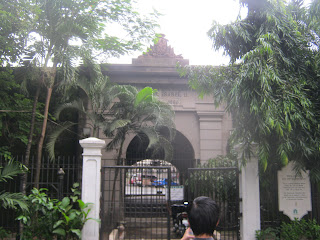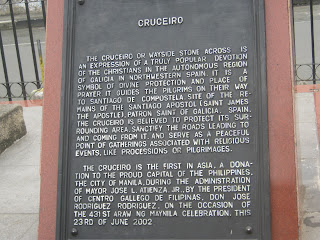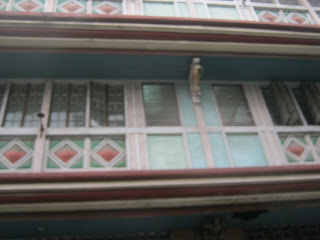I was very fortunate to join Mr. Rence Chan's Pilipinas Stamp Collectors' Club Postal Heritage Tour and I would like to share the site and experience to all of you.
We start at the National Press Club Building.
The four-storey main building was built in June 1954 and inaugurated on December 30, 1955 by President Ramon Magsaysay. It was designed by the late Angel E. Nakpil as one of the modern and first earthquake-proof buildings in the Philippines, and constructed by Engr. Alberto T. Abaya.
Just outside the National Press Club building is a statue of Garciano Lopez Jaena.
Graciano López Jaena (December 18, 1856-January 20, 1896) was a Filipino journalist, orator, and revolutionary from Iloilo, well known for his written work, La Solidaridad.
Philippine historians regard López Jaena, along with Marcelo H. del Pilar and José Rizal, as the triumvirate of Filipino propagandists. Of these three ilustrados, López Jaena was the first to arrive and may have founded the genesis of the Propaganda Movement.
 |
| Trivial things. I always love taking pictures of trivial stuffs in the street. Now here is a mother cat with 4 offspring. According to the owner, the four dark-haired kittens are all adopted. |
Now here's the monument in honor of Reyna Dona Isabel II (Queen of Spain). That's in Intramuros near Peursta De Isabel. This bronze statue of Queen Isabela II was erected on July 14, 1860 in Plaza Arroceros (now called Liwasang Bonifacio). Most Manila historians say that this is the only statue of Queen Isabella II that depicts her at a younger age. It is also the only one here in Asia. Ok, so blame it to Ponciano Ponzano who created this statue.
Anyway, reading an article in Wikipedia, I learned that Queen Isabel II was exiled, after her Moderado generals had made a slight show of resistance that was crushed at the Battle of Alcolea by Generals Serrano and Prim. This revolt, which deposed Isabella, is known as the Glorious Revolution, and ushered the First Spanish Republic into power.
And the story of the statue is as colorful as that of the Queen.
Carlos María de la Torre, the appointed governor-general of the Philippines, wants to remove all the remnants of the old regime in Manila and set in to destroy the monument of the Queen. The task of destroying the monument was given to Bartolome Barretto, a government official. A sympathizer of the Spanish crown, he refused to carry out the task. Chinese workers were hired to remove the statue and Barretto hid it in his house before the Ayuntamiento reclaimed it. The Sociedad Economica de Amigos del Pais (Economic Association of Friends of the Country) requested that the statue be made part of their museum collection, but de la Torre consigned it to a storeroom in the Casas Consistoriales.
The statue was brought out and erected in front of the Malate Church in 1896. It remained there for over half a century until in 1970 when it was blown down by Typhoon Yoling. The monument was transferred to its present site during the visit of Prince Carlos of Spain in 1975.
This is one of the gates of Intramuros (Most wiki says that there are 8 gates) Built in 1861, this was the last gate to be opened in Intramuros' walls under Spanish rule. Puerta Isabel II became part of the route of the tranvía (streetcar) that started in 19th century Manila. It was damaged during the Battle of Manila in 1945 and restored in 1966.
Next is the Cruceido.
This Cruceiro is the first in Asia, a donation to the proud capital of the Philippines, the city of Manila, during the administration of Mayor Jose L. Atienza Jr., by the president of Centro Gallego de Filipinas, on the occasion of the 431st araw ng Maynila Celebration, this 23rd of June 2002.
This is the remains of the Aduada or the Custom House, where goods and mails were declared for custom purposes. It was destroyed in World War 2 during the Battle of Manila.
Below is the marker that commemorates the Manila-Acapulco Galleon Trade. For your information, the Manila-Acapulco Galleon Trade (Spanish: Galeones de Manila-Acapulco) or in (Tagalog: Kalakalang Galyon ng Maynila at Acapulco) were Spanish trading ships that sailed once or twice per year across the Pacific Ocean between Manila in Spanish East Indies (present day-Philippines), and Acapulco, New Spain (present-day Mexico). The name changed to reflect the city that the ship was sailing from.
The trade route was inaugurated in 1565 with the discovery of the ocean passage by Andrés de Urdaneta, and continued until 1815 when the Mexican War of Independence put a permanent stop to the galleon trade route.
A statue of Adolfo Lopez Mateo -President of Mexico, known to some residence here as "TATANG."
The statue of King Philip II of Spain, where the name Philippines came from.
Now here's the Manila Cathedral, one of the oldest basilica in the Philippines and the seat of the Archbishop of Manila during the Spanish period. According to Wiki, this cathedral was dedicated to the Blessed Virgin Mary as Our Lady of the Immaculate Conception, the Principal Patroness of the Philippines. The cathedral serves as the seat of the archbishop of the Roman Catholic Archdiocese of Manila. It was officially established in 1571 by Padre Juan de Vivero.
It suffered a lot of damage due to earthquakes and was reduced to rubble by the bombing in 1945 during the Battle of Manila. Fortunately, it was always being restored.
The Bahay Tsinoy
A museum located in the Intramuros (Old Walled City) section of Manila. Housed within the Kaisa-Angelo King Heritage Center building, the museum documents the history, lives and contributions of the Chinese in the Philippine life and history.
It was designed by Eva Penamora in collaboration with the late architect Honrado Fernandez in 1996, and completed and inaugurated in 1999.
A Foo Dog and replica of a Terra Cotta warrior greets visitors in its lobby, a gift from the Embassy of People's Republic of China.
 |
| It is said that you have to touch that round ball inside a Foo Dog's mouth and make a wish. |
Colegio de San Juan de Letran on 151 Muralla St. Intramuros. Sadly, this wall is just a memory since it was already demolished.

































































































No comments:
Post a Comment